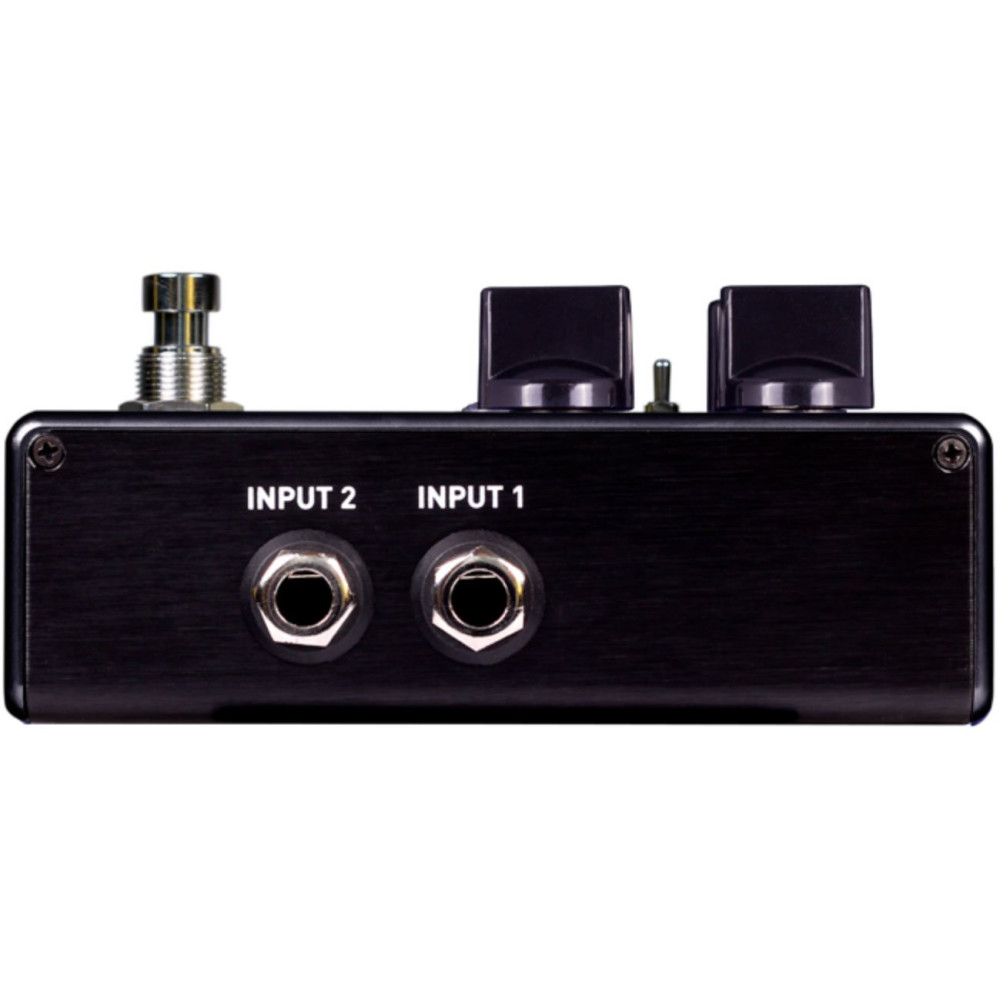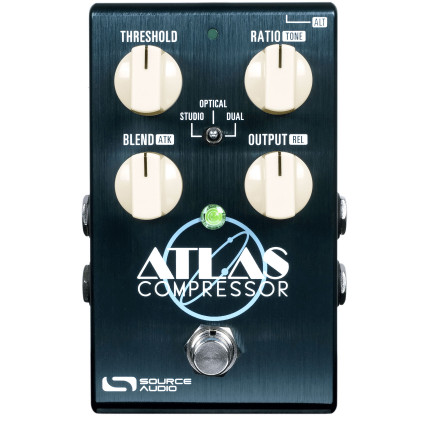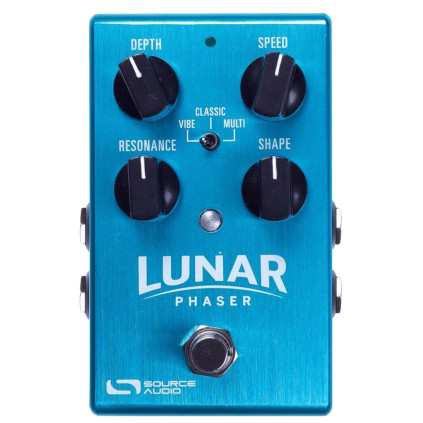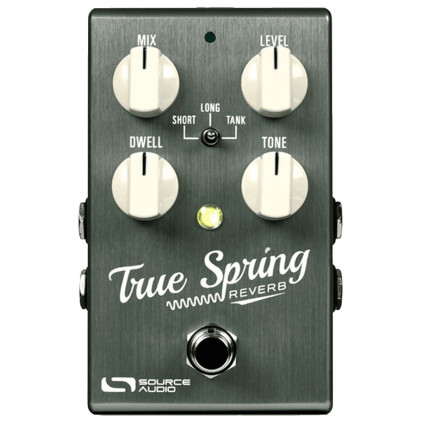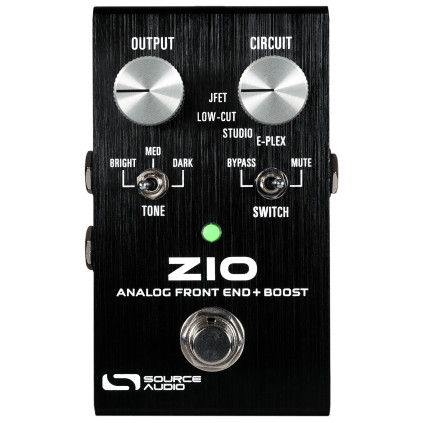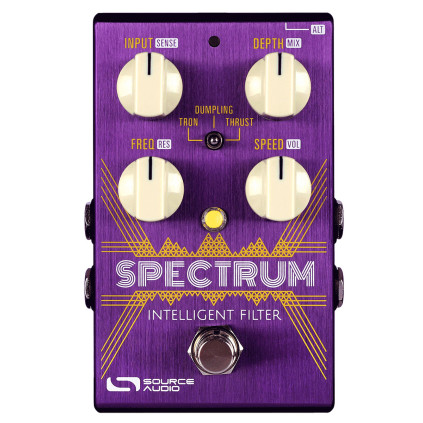Multi-dimensional overdrive og tremolo pedal som ingen andre!
Transform Your Guitar Tone with Multiband Saturation and Tremolo
It's safe to say bands like Muse and Rage Against the Machine wouldn't have made their marks without the quixotic tone tastes of Matt Bellamy and Tom Morello. If you're the type of player who shares a penchant for nontraditional fuzz/distortion sounds and synthy cascades of color, there's a slew of gooey, glitchy character tones to be discovered in the Source Audio Ultrawave pedal. A unique multiband approach to tone structuring gives the Ultrawave the edge for the hard-clipped squelchy fuzzes and infinite-sustain exploratory leads that are so hard to achieve with traditional clipping circuits.
Ultrawave splits polyphonic synth and guitar signals in up to 10 bands and lets users crank and saturate each to taste, yielding some of the filthiest riff distinguishers on the planet. Naturally, Ultrawave does doom, desert, and industrial with aplomb. But this pedal's softer side will surprise you. A mature multiband compressor and a custom-waveform stereo tremolo can be called up quickly using the free Neuro Editor desktop/mobile app. Speaking of which, tone chasers will love all the bells and whistles inside Neuro Editor, where you'll find loads of fresh-baked factory presets waiting to transform your pedestrian guitar/synth lines into surges of supermassive hysteria.
A pioneering approach to traditional effects
The Source Audio Ultrawave pedal takes a pioneering approach to traditional broadband overdrive, tremolo, and compression effects. By splitting each band of a polyphonic guitar or a synthesizer signal into up to 10 bands and letting users treat each band as its own signal — each complete with its own adjustable parameters — Ultrawave is able to forge new ground for the adventurous sonic spelunker.
What can the Ultrawave do?
- Heaps of utterly unique overdrive tones: Ultrawave's band-split technology can be applied to a plethora of exciting overdrive types: tube, op-amp, diode, gated, octave-up, foldback, and more.
- Foldback distortion: This synth-derived distortion type is a callback to Source Audio's Soundblox Multiwave pedal. Fans describe its sound as aggressive, glitchy, squelchy, and over-the-top buzzy — in short, it knows how to make an entrance.
- Full-fat chordal crunch: Many of our favorite clipping circuits of the past have a tendency to scoop out those vital lows. That's not the case with Ultrawave. Since signals can be split into separate bands and processed individually, this pedal succeeds in preserving those earthquaking fundamentals and chunky second-order octave harmonics, no matter how much gain is slathered on.
- Pulsing waves of dancing, driven tremolo: Rhythmic arpeggiated soundscapes and old-school harmonic amp tremolo are two areas where Ultrawave really shines.
- Advanced stereo effects: Want to send two entirely different drive effects to each of Ultrawave's outputs? Looking for a ping-pong stereo that bounces from ear to ear? You'll find these and much more in this pedal.
- Compression, tremolo, LFO, and more: There's plenty more tone-shaping potential to be discovered in Ultrawave by engaging its Sound Processing Blocks.
Ripe for sonic experimentation
The Source Audio Ultrawave is for any guitar/synth player who's mental about the experimental. If you've got a will for uncovering a particular type of uncommon distortion effect, the Ultrawave more than likely has a way.
Spans nuanced effects to sonic extremes
The multiband Ultrawave can achieve so many sounds that's it hard to put a finger on what it sounds like. It's West Coast doom with a high-rising terminal. Retrofuturism with a side of synthwave. A sputtering Tesla coil fed by a starved watched battery. A symphony of clipping diodes. A pathway to chiptune nirvana. A synthesist's holiday. Stoner rock a-go-go.
And that's just to call out its extremes. The Source Audio Ultrawave certainly packs more nuanced effects, including tubelike overdrive, throbbing opto-tremolo, and even ultra-clean multiband compression and arpeggiation.
Sound Processing Blocks
We think the Source Audio Ultrawave's additional Sound Processing Blocks take it from great to legendary. Here you'll discover a stack of mature tone enhancers to use on their own or in conjunction with this pedal's mark-making drive and distortion sounds.
- Dual-channel Compressor: A studio-level compressor that can be placed before or after the drive circuit, it can squash signals running into a fuzz or balance out levels coming out of a sputtery overdrive.
- Multiband Tremolo: This block supplies an impressive range of juicy trem effects with both traditional (Depth, Rate) and unconventional (Onset, LFO Wave Shape) controls. Manipulating these, you can create everything from traditional amp tremolo to sequencer-type chased note sequences.
- LFO Ring Mod: This option adds ring modulation to your tremolo's LFO to fatten up tones and create clangorous metallic sounds.
- Morph: How would you like to blend seamlessly between two turbocharged tones using an optional expression pedal? It's all possible within the Source Audio Ultrawave.
Tap into Ultrawave's potential with the Neuro Editor (Mac/PC/iOS)
Obviously, a pedal as sophisticated as the Source Audio Ultrawave can be a little daunting for players to dive right into. Fortunately, a wealth of artist presets can be accessed within the free Source Audio Neuro Editor desktop software and mobile app. Whether you're looking for a special tone to make an instrument part pop or you just want an entry point to building the tone of your dreams, the Neuro Editor is the place to start working your way into all Ultrawave can accomplish. Neuro Editor also makes a one-stop shop for the sonic fruits of your tonal labors — you can catalog favorites and user presets for later recall.
Features:
- Takes a pioneering approach to traditional broadband guitar/synth effects
- Jam-packed with nontraditional fuzz/distortion tones and synthy cascades of color
- Splits incoming signals into as many as 10 bands, each with independent Drive and Level controls
- Band splitting can be applied to traditional (tube, op-amp, diode) as well as nontraditional (octave, foldback) saturation effects
- Rich stereo tremolo with variable LFO wave shape
- Able to create sounds reminiscent of sequencer and arpeggiator effects
- Multiband compressor can be placed before or after drive circuits
- Neuro Editor software (Mac/PC/iOS) lets you save and call up presets or discover fresh tones
- Dual outputs can be assigned to stereo ping-pong effects or to sending out 2 entirely different signals
Specs:
- 37 Different Band Splitting Options: Band Splitting options including single, 2, 3, 4, 8, and 10 bands. Each band splitting option includes several sub-sets with different band splitting frequency points.
- 44 Different Distortion Types: Choose from distortion/overdrive/fuzz types that include Tube, Diode, Foldback, Negative Flip Diode, Octave Up, and more.
- Dual Channel Compressor/Expander: Compressor features Input Gain, Threshold, Ratio, Attack, Release, and Output Gain controls with a detailed graphic monitor. Use the dual channel capabilities to isolate compression to specific frequencies. Place the compressor/expander before or after the overdrive module.
- Growing Library of Published Presets: For quick and easy access to a world of great tones, try sampling sounds from a vast collection of published presets created by the Source Audio team and the ever-growing Ultrawave Neuro Community.
- Stereo Ins and Outs: Create two entirely different presets and run them in series, parallel or run each to a separate output. Stereo options also apply to the Multiband Tremolo - use the Channel 1/Channel 2 Sync options or the Phase Offset control to create stereo ping-pong, tremolo effects.
- Detailed LFO Controls: Use the LFO module to control the Ultrawave's Tremolo, Morphing or Ring Mod features. Choose between a standard Sine Wave or use the Attack/Release controls to create highly customized LFO shapes.
- Sound Morphing: Change from one sound to another with an expression pedal, envelope follower or LFO.
- 8 Band Graphic Equalizer
- Adjustable Noise Gate
- Assignable Knobs: Reassign all four of the Ultrawave's knobs to the parameters most useful for making quick, on-stage changes. Save a different set of knob assignments for every preset.
- External Expression Pedal Control: Make simultaneous, on-the-fly changes of up to three parameters with an external expression pedal.
- 6 Toggle Switch Accessible Presets: Quickly access up to 6 pedal presets with the Ultrawave's toggle switch.
- Universal Bypass — Select either analog buffered or relay based True Bypass.
- MIDI Capable — Connect the Ultrawave to the Source Audio Neuro Hub and access up to 128 presets with MIDI Program Change (PC) messages. Control many of the pedal’s parameters with MIDI Continuous Controller (CC) messages or assign LFO modulation speed with MIDI Clock.
- USB Port - Class compliant USB-MIDI allows the Ultrawave to work as a plug-and-play device with recording software running on Mac and Windows. The USB port offers connectivity to the Neuro Desktop Editor providing access to deep editing possibilities and pedal firmware updates.
- Compact Design – The durable, anodized aluminum housing has a small footprint and sturdy hardware. Dimensions: L: 4.5 in./11.4cm x W: 2.75 in./7cm x H: 2 in./5.1cm (including knobs).
- Universal BypassTM – Select either analog buffered or relay based True Bypass.



